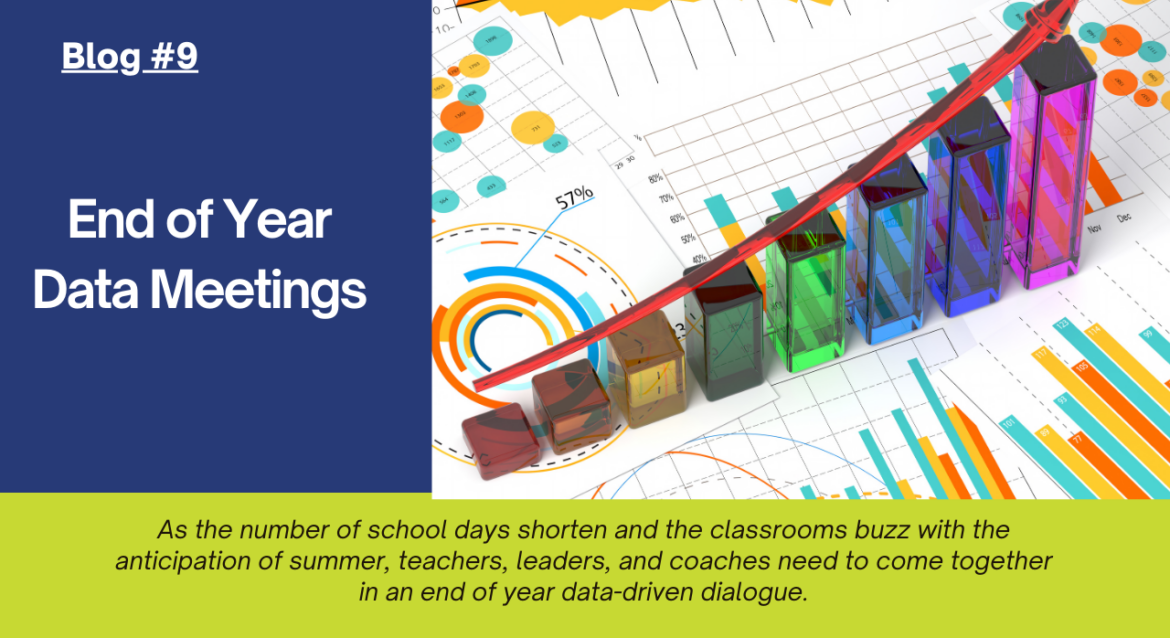
As the number of school days shorten and the classrooms buzz with the anticipation of summer, teachers, leaders, and coaches need to come together in an end of year data-driven dialogue.
Harnessing Data to Propel Forward
It’s time for the End-of-Year (EOY) Data Meetings—a time to reflect and distill the year’s learning into insights and action. Listed in this blog are some ideas to add to your EOY Data Meetings and step-by-step checklists and data protocols you may want to use.
Summative Assessments: Reflecting on Mastery and Milestones
In the bright and bustling library, our team gathers, focused not just on numbers but on the stories they tell. We begin with our focus: “What has been the impact of our literacy instruction?” “What has been the impact of our math instruction?” Success is our starting point, each teacher sharing a triumph—perhaps the unexpected surge in reading levels or a student finally grasping the concept of fractions and showing mastery on the end of year assessment.
“We saw over 80% proficiency in foundational reading skills,” beams a first-grade teacher, pointing to a colorful graph, that shows more green and blue and less yellow and red. This is met with nods of affirmation, from the entire first-grade team.
Yet, the narrative deepens as we consider the challenges. “We’ve made strides, but nearly 30% still struggle with comprehension,” another adds, marking the standards needing reinforcement.
The discussion turns collaborative, with a coach offering to meet with the team to discuss ideas for next year to strengthen comprehension instruction. The second-grade team asks the first-grade team if they could meet and discuss individual students and their needs with comprehension for next year. Together, we celebrate the small victories while preparing to strengthen our instruction in all tiers of instruction.
Grade-Level Achievement: Zooming In on Progress
Teachers share their observations, dissecting the strengths and challenges that their collective data unveil in all content areas and across all grade levels.
The science department shares a striking pattern: students excel in hands-on experiments but stumble in writing in their science lab notebooks. The team asks the coach and leader for support in teaching students how to write like scientists.
In the final English department meeting of the year, the air is filled with a mix of fatigue and anticipation. The department chair takes time to celebrate achievements of all courses including that 80% of students in Freshman English were proficient on the last unit essay. Then, the department chair reflects on data that needs next steps, “Our data across all courses is showing that students are still struggling with connecting valid reasoning and sufficient evidence.”
There’s a pause as the room absorbs this information. “So, what’s our next step?” a teacher asks. The group agrees on a more hands-on approach to essay writing for the coming year, starting with clear, guided examples using rubrics and scaffolds (i.e., exemplars, paragraph frames for reasons and evidence) and a plan for progressing to independent analysis.
Data Deep Dives: Understanding Beyond the Surface
In each school, teachers turn detectives, as they dive deep into individual student performance, looking for patterns across classes and content areas and in all tiers of instruction.
Elementary teachers reflect on a body of evidence to determine strengths and areas for improvement in whole group, small group, and interventions for students not yet showing proficiency in meeting grade level standards.
Middle school teams brainstorm on bridging gaps revealed in grade level common assessments and ideas for strengthening interventions that have not shown significant progress in closing skills gaps. They delve into specifics, like which subjects saw the most improvement and how student relationships have been strengthened and motivation for attending class and completing assignments has increased.
High school teachers evaluate how assessments forecast students’ readiness for the next grade level and strategize how to support students in core classes, advisory, and interventions. An additional session is scheduled to discuss how best to support students receiving Title I and special education services in meeting grade level standards.
Celebrating Growth: The Story Continues
Finally, in a culture of continuous improvement, each data meeting concludes with the setting of clear, actionable next steps. Teachers leave not just with plans, but with a renewed sense of purpose. They pledge to celebrate growth, scaffolds that supported learning, and the strategies that will lead their students into the next academic year.
In Conclusion: Data as a Springboard for Stories of Success
As the meetings draw to a close, we recognize that these are not just meetings but milestones. In these sessions, data is not an end but a beginning—a launchpad for stories of success waiting to be written in the year to come.
For resources to further this narrative click the checklists below, or email Debbie for a video recording of an EOY data meeting for elementary schools and any of the checklists in Word documents so you can make them your own. [email protected].
If you are using STRIVE’s Data System; a how-to on planning, teaching, and assessing reading groups, be sure to revisit pages 38-42. https://www.strivetlc.com/strives-data-system/
Be sure to visit www.strivetlc.com for lots of free resources.
We must take care of the teachers, leaders, and coaches that take care of our children
-Debbie
Our aim is simple: to provide as many helpful resources as possible to teachers, leaders, and coaches. Every comment you make and every share helps us achieve this goal.
Leave a Comment: Your thoughts and experiences are valuable to us and other readers. Join the conversation and help us all learn more!
Share with Others: Know other teachers who could benefit from our resources? Spread the word and help us reach more educators


